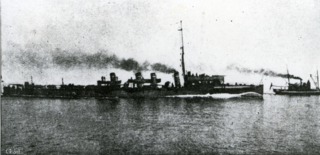 HMS Cricket | |
| Class overview | |
|---|---|
| Name | Cricket class and subsequent classes |
| Builders | J S White, Thornycroft, Yarrow, Denny, Hawthorn Leslie, Palmer |
| Operators | |
| Completed | 36 |
| Lost | 6 |
| Scrapped | 30 |
The Cricket class and following classes of coastal destroyers were a series of small torpedo boat destroyers (TBDs) intended to complement the Royal Navy's Tribal-class destroyers. The thirty-six vessels which broadly comprised this group actually consisted of several distinct classes, as each contractor built to their own designs, and even single contractor's designs evolved from year to year.
Contents
- Cricket-class (TB.1 to TB.5 - J. S. White 1905–1906 programme)
- Gadfly-class (TB.6 to TB.10 - Thornycroft boats - 1905–1906 programme)
- Mayfly Class (TB.11 to TB.12)
- TB.13 Class (TB.13 to TB.16)
- Notes
- Citations
- References
The first twelve vessels (comprising White's Cricket class, Thornycroft's Gadfly class and Yarrow's Mayfly class) were ordered in 1905 and launched in early 1906. In practice they were not strong enough for open ocean operations and were reclassified as 1st class torpedo boats. These first twelve had been given names but in October 1906 - after the first two vessels ran trials but before any had been delivered - all were then given the numbers TB 1 to TB 12 and their names were withdrawn.
The following two batches—each of twelve more boats, comprising TB 13 to TB 24 ordered under the 1906–07 Programme, and TB 25 to TB 36 under the 1907–08 Programme—were only ever given numbers and were on average 10 ft (3.0 m) longer. These were only ever classified as 1st class torpedo boats. The last boat was launched in 1909. Those that survived the war (six were wartime losses - four from the 1905-06 batch and two from the 1906-07 batch) were sold off from 1919 to 1921.
They were built by six different yards (thirteen by White at Cowes, nine by Thornycroft (five at Chiswick and four at Woolston, Hampshire), four each by Denny at Dumbarton and by Hawthorn Leslie at Hebburn, and three each by Yarrow at Cubitt Town and by Palmers at Jarrow).
The boats differed in detail as each shipbuilder was allowed to construct to their own design, and the designs were modified and enlarged for the later batches, but all had two funnels with one of the torpedo tubes on the stern. These vessels closely resembled the earliest 26-knotter TBDs of 1892–93, having 'turtle-back' forecastles and carried a similar armament.
By 1914 all boats were serving in North Sea Patrol Flotillas or the Nore Local Defence Flotilla. TB 4 and TB 24 won the Battle Honour Belgian Coast 1915. In 1918 the four Denny-built boats were sent to the Mediterranean: TB 17 and TB 18 served at Gibraltar, TB 29 and TB 30 at Malta, where these went to the breakers in 1919.









